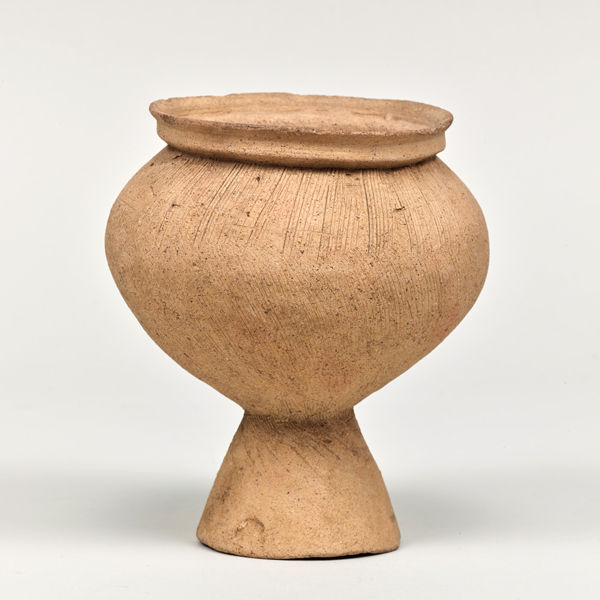政治的社会の成熟―宝器の創出―
-

S字状口縁甕 群馬県高崎市綿貫出土 古墳時代・4世紀
平成館 考古展示室
2023年7月11日(火) ~ 2023年12月3日(日)日本列島における政治的社会の成熟は、弥生時代末頃に各地に出現した大規模な墳丘をもつ墳墓と、古墳時代初頭の大規模な前方後円墳の成立から知ることができます。このような転換期の動向を土師器の成立とその地域間交流、および三角縁神獣鏡の成立とその文様の多様性と変遷で展示します。今回は西日本と東日本各地の特徴的な土師器を展示し、地域の独自性と、広域的な共通性の双方を紹介します。
| 指定 | 名称 | 員数 | 作者・出土・伝来 | 時代・年代世紀 | 所蔵者・寄贈者・列品番号 | 備考 | |
| おすすめ | 二重口縁壺 | 1個 | 大阪府豊中市 庄内遺跡出土 | 古墳時代・3世紀 | 橋本宗太郎氏寄贈 J-23884 | ||
| 二重口縁壺 | 1個 | 大阪府柏原市・藤井寺市 船橋遺跡出土 | 古墳時代・3~4世紀 | 田村淳正氏寄贈 J-38899-1 | |||
| 二重口縁壺 | 1個 | 東京都あきるの市草花小宮神社敷地出土 | 古墳時代・4世紀 | 塩野半十郎氏寄贈 J-38278 | |||
| 二重口縁壺 | 1個 | 福岡県宗像市上八出土 | 古墳時代・3~4世紀 | J-36938 | |||
| おすすめ | S字状口縁甕 | 1個 | 群馬県高崎市綿貫出土 | 古墳時代・4世紀 | J-6124 | ||
| S字状口縁甕 | 1個 | 大阪府柏原市・藤井寺市 船橋遺跡出土 | 古墳時代・3~4世紀 | 田村淳正(たむらあつまさ)氏寄贈 J-38859-16 | |||
| 台付甕 | 1個 | 東京都あきる野市原小宮出土 | 古墳時代・4世紀 | 塩野半十郎氏寄贈 J-38258 | |||
| 低脚坏 | 1個 | 島根県安来市 大成古墳出土 | 古墳時代・4世紀 | J-6608 | |||
| 大型鉢(山陰系) | 1個 | 大阪府柏原市・藤井寺市 船橋遺跡出土 | 古墳時代・3~4世紀 | 田村淳正氏寄贈 J-38862 | |||
| 高坏 | 1個 | 東京都あきる野市原小宮出土 | 古墳時代・4世紀 | 塩野半十郎氏寄贈 J-38260 | |||
| 高坏 | 1個 | 群馬県高崎市綿貫出土 | 古墳時代・4世紀 | J-6123 | |||
| 高坏 | 1個 | 大阪府豊中市 庄内遺跡出土 | 古墳時代・4世紀 | 橋本宗太郎氏寄贈 J-23896 | |||
| 小型壺 | 1個 | 宮城県仙台市 南小泉遺跡出土 | 古墳時代・4~5世紀 | J-36636-4 | |||
| 小型壺 | 1個 | 茨城県石岡市柿岡出土 | 古墳時代・4世紀 | J-6264 | |||
| 小型丸底壺 | 1個 | 大阪府柏原市・藤井寺市 船橋遺跡出土 | 古墳時代・4世紀 | 田村徳氏寄贈 J-38857-8 | |||
| 小型器台 | 1個 | 茨城県小美玉市美野里町竹原出土 | 古墳時代・4世紀 | 増澤総蔵氏寄贈 J-7167 | |||
| 小型器台 | 1個 | 大阪府柏原市・藤井寺市 船橋遺跡出土 | 古墳時代・3~4世紀 | 田村徳氏寄贈 J-38866-3 | |||
| 小型器台 | 1個 | 福岡市博多区千代出土 | 古墳時代・4世紀 | 花井重太郎氏寄贈 J-7762-1 | |||
| 装飾器台 | 1個 | 東京都大田区久が原出土 | 古墳時代・4世紀 | 個人蔵 | |||
| 模造 三角縁二神六獣鏡 | 1面 | 原品:岡山市 備前車塚古墳出土 | 原品:古墳時代・3~4世紀 | J-39193 | |||
| おすすめ | 重文 | 三角縁四神四獣鏡 | 1面 | 群馬県前橋市 前橋天神山古墳出土 | 古墳時代・4世紀 | J-38398-1b | |
| 三角縁三神三獣鏡 | 1面 | 京都府長岡京市 長法寺南原古墳出土 | 古墳時代・4世紀 | J-22533 | |||
| 模造 三角縁獣文帯五神四獣鏡 | 1面 | 原品:岡山市 備前車塚古墳出土 | 原品:古墳時代・3~4世紀 | J-39196 | |||
| 三角縁神獣車馬鏡 | 1面 | 滋賀県野洲市 大岩山古墳出土 | 古墳時代・4~5世紀 | 沢友之進氏・小林九市氏寄贈 J-9306 | |||
| 模造 三角縁陳是作四神二獣鏡 | 1面 | 原品:岡山市 備前車塚古墳出土 | 原品:古墳時代・3~4世紀 | J-39195 | |||
| 三角縁三神三獣鏡 | 1面 | 奈良県広陵町 新山古墳出土 | 古墳時代・4世紀 | 宮内庁書陵部蔵 | |||
| 三角縁二神二獣鏡 | 1面 | 奈良県桜井市金崎出土 | 古墳時代・4世紀 | 岡田奈良吉氏寄贈 J-2591 | |||
| 三角縁三神二獣鏡 | 1面 | 兵庫県神戸市 ヘボソ塚古墳出土 | 古墳時代・4世紀 | J-2264 | |||
| 模造 三角縁二神二獣鏡 | 1面 | 原品:静岡県磐田市 松林山古墳出土 | 原品:古墳時代・4世紀 | J-39192 | |||
| 三角縁二神二獣鏡 | 1面 | 出土地不詳 | 古墳時代・4世紀 | J-38399 | |||
| 三角縁三神三獣鏡 | 1面 | 岐阜市 坂尻1号墳出土 | 古墳時代・4世紀 | 川島清兵衛氏・川島浅右衛門氏寄贈 J-8142 | |||
| 三角縁三神三獣鏡 | 1面 | 奈良県広陵町 新山古墳出土 | 古墳時代・4世紀 | 宮内庁書陵部蔵 | |||
| 三角縁三神三獣鏡 | 1面 | 大阪府高槻市阿武野出土 | 古墳時代・4世紀 | J-8114 | |||
| 三角縁三神三獣鏡 | 1面 | 島根県安来市 造山1号墳出土 | 古墳時代・4世紀 | J-33867 | |||
| 三角縁三神三獣鏡 | 1面 | 愛知県春日井市 出川大塚古墳出土 | 古墳時代・4世紀 | J-2599 | |||
| 三角縁三神三獣鏡 | 1面 | 佐賀県唐津市 谷口古墳出土 | 古墳時代・4~5世紀 | J-6197 | |||
| 三角縁神獣車馬鏡 | 1面 | 山梨県甲府市 甲斐銚子塚古墳出土 | 古墳時代・4世紀 | J-20305 | |||
| おすすめ | 重文 | 三角縁竜虎鏡 | 1面 | 大阪府和泉市 和泉黄金塚古墳出土 | 古墳時代・4~5世紀 | J-36931-23 | |
| 模造 旋帯文石 | 1個 | 原品:岡山県倉敷市 楯築神社伝世 | 原品:弥生時代・3世紀 | J-38389 |
